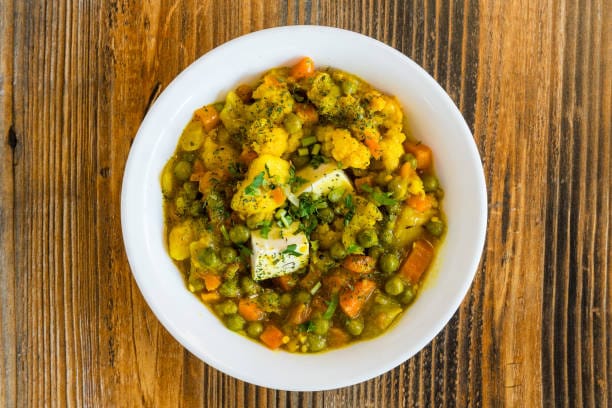Étouffée is a classic dish rooted in the rich culinary tradition of Cajun and Creole cuisine, often associated with Louisiana. Traditionally made with seafood or meat, this flavorful dish gets its name from the French word “étouffée,” meaning “smothered” or “suffocated.” It reflects the way the food is slowly cooked, allowing the ingredients to meld together into a deeply satisfying meal. In this vegetarian version, we’re keeping the robust flavors but eliminating the animal products to create a dish that’s just as savory, hearty, and comforting as the original.
Whether you’re a vegetarian, experimenting with plant-based meals, or simply craving a delicious Southern-inspired dish, vegetarian étouffée is a fantastic option. Let’s dive into how you can craft this flavorful dish at home.
What Is Étouffée?

Étouffée typically features a rich, thick sauce made from a roux, the “holy trinity” of Cajun cooking (onions, celery, and bell peppers), and a blend of seasonings, all slowly simmered to perfection. It’s traditionally served over rice, which helps to soak up the sauce. The non-vegetarian versions are often made with shrimp, crawfish, or chicken, but in this recipe, we’ll be swapping out the protein for hearty vegetables, tofu, and plant-based sausage, while keeping the essence of étouffée intact.
Ingredients for Vegetarian Étouffée

Here’s what you’ll need for a vegetarian take on this Louisiana classic:
Vegetables and Plant-Based Proteins:
- Tofu or Tempeh: Provides protein and a satisfying texture.
- Plant-Based Sausage: A spicy, smoky sausage adds extra depth and flavor.
- Bell Peppers, Celery, and Onion (The Holy Trinity): These three ingredients are foundational to Cajun cooking.
- Tomatoes: Adds a subtle sweetness and acidity to the dish.
- Mushrooms: An earthy and savory substitute for seafood or meat.
- Garlic: Enhances the flavor of the sauce.

For the Roux:
- Flour: Forms the base of the roux, the thickening agent for the étouffée.
- Oil or Vegan Butter: Used to brown the flour for the roux.
Spices and Seasonings:
- Cajun Seasoning: A blend of spices like paprika, garlic powder, onion powder, cayenne pepper, and thyme.
- Bay Leaves: Adds depth and complexity to the sauce.
- Hot Sauce (Optional): For those who enjoy a bit of heat.
- Salt and Pepper: To taste.
Liquids:
- Vegetable Broth: Forms the base of the sauce.
- Soy Sauce or Tamari: Adds umami flavor.
- Tomato Paste: Helps thicken the sauce while adding richness.
For Serving:
- Rice: White or brown rice is traditionally served underneath the étouffée, soaking up all the flavorful sauce.
- Chopped Green Onions or Parsley: For garnish.
How to Make Vegetarian Étouffée

1. Make the Roux
Start by making the roux, which is the backbone of any good étouffée. Heat oil or vegan butter in a large skillet over medium heat, and whisk in the flour. Stir constantly to ensure it doesn’t burn, and cook until the mixture turns a deep golden-brown color. This can take around 10 to 15 minutes, depending on the heat and your stovetop. A well-made roux will give your étouffée that rich, savory flavor that’s so iconic in Cajun cuisine.
2. Sauté the Vegetables
Once your roux is ready, add in the diced onion, celery, and bell peppers—the holy trinity of Cajun cooking. Sauté the vegetables until they soften, releasing their flavors and becoming aromatic. This step is crucial for building layers of flavor. Next, stir in the garlic and cook for another minute until fragrant.
3. Add the Proteins and Mushrooms
Now, it’s time to incorporate your plant-based proteins and mushrooms. If you’re using tofu or tempeh, you can cube them and add them directly to the skillet. Sauté them until they develop a slight crust, which helps them hold up in the sauce. Add the sliced plant-based sausage next and cook until browned on the edges.
4. Simmer the Sauce
Pour in the vegetable broth, soy sauce, tomato paste, and diced tomatoes, stirring to combine. Add Cajun seasoning, bay leaves, and any additional salt or pepper. Let the mixture come to a simmer, allowing the flavors to meld together and the sauce to thicken. This process should take about 20 to 30 minutes. If you prefer a spicier étouffée, this is the time to add hot sauce or additional cayenne pepper.
5. Final Adjustments
Taste your sauce and adjust the seasonings as needed. If the sauce becomes too thick, you can add a little more vegetable broth to thin it out to your desired consistency. The goal is a gravy-like sauce that will coat the rice perfectly.
6. Serve Over Rice
Prepare a bed of white or brown rice in bowls and ladle the vegetarian étouffée generously over the top. Garnish with chopped green onions or parsley for a fresh burst of color and flavor.
Vegetarian Étouffée Variations

One of the wonderful things about vegetarian étouffée is that it’s easily customizable based on your preferences and what ingredients you have on hand. Here are a few variations you might consider:
- Jackfruit Étouffée: For a texture that mimics the pull-apart nature of seafood, you can substitute jackfruit for tofu or tempeh. Jackfruit absorbs the flavors of the sauce beautifully and offers a satisfying bite.
- Chickpea Étouffée: Chickpeas add a great texture and a hearty dose of plant-based protein to the dish.
- Sweet Potato or Butternut Squash: Roasted sweet potatoes or butternut squash cubes add a touch of sweetness that contrasts nicely with the spicy Cajun seasoning.
- Okra: Incorporating okra adds an authentic Southern feel, plus it’s a great way to thicken the sauce even more.
The Magic of Cajun Seasoning

At the heart of this dish is the Cajun seasoning. A good blend should include paprika, garlic powder, onion powder, black pepper, cayenne pepper, thyme, and oregano. You can adjust the ratios of these spices to suit your taste preferences. If you’re making your own Cajun seasoning, feel free to experiment with the heat level by adding more or less cayenne pepper.

The Cajun seasoning is what gives étouffée its signature flavor—a balance of smoky, spicy, and savory notes that define this cuisine. While store-bought blends are convenient, homemade versions allow for more control and customization.
Health Benefits of Vegetarian Étouffée

Opting for a vegetarian version of étouffée comes with its own set of health benefits. By focusing on plant-based ingredients, this version is naturally lower in saturated fats and cholesterol, making it a heart-healthy choice. Plus, the addition of vegetables, tofu, and plant-based sausages means you’re getting a good dose of fiber, protein, and essential nutrients without sacrificing flavor.

Some key health highlights include:
- Rich in Fiber: The vegetables and plant-based proteins provide ample fiber, which is essential for digestion and overall gut health.
- Lower in Saturated Fats: Swapping out seafood or meat for tofu and mushrooms reduces the saturated fat content.
- Vegan-Friendly: This recipe is completely vegan, making it suitable for a variety of dietary preferences.
- Packed with Antioxidants: Bell peppers, tomatoes, and garlic are all rich in antioxidants that help protect your body from oxidative stress.
Conclusion: A Hearty Dish for All
Vegetarian étouffée proves that you don’t need seafood or meat to enjoy the robust, comforting flavors of this beloved dish. With its bold Cajun seasoning, thick sauce, and satisfying plant-based ingredients, this recipe is perfect for anyone looking to explore Southern cuisine in a new and delicious way. Whether you’re serving it to family, impressing guests at a dinner party, or simply enjoying a cozy night in, vegetarian étouffée is sure to be a hit.




